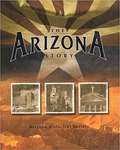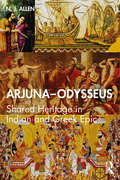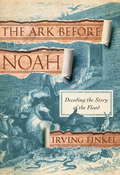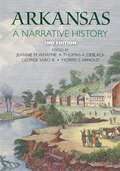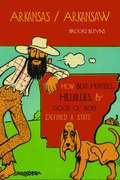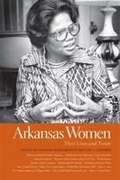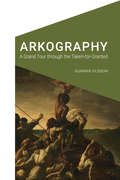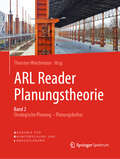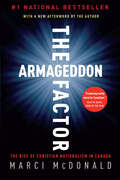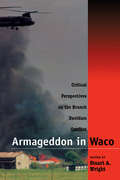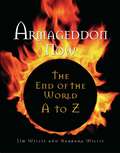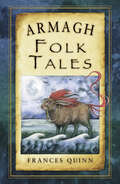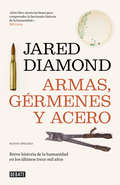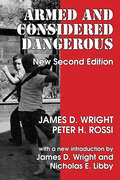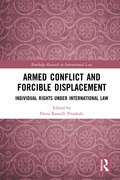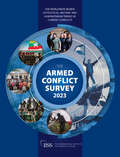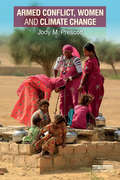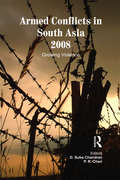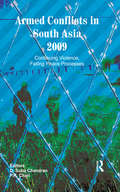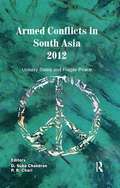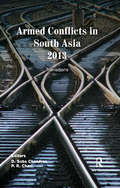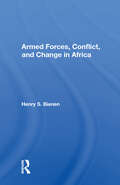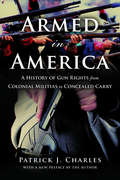- Table View
- List View
The Arizona Story
by Arizona Historical SocietyThe Arizona Story is a brand-new 4th grade Arizona history textbook. Because the outline for this book was based on the Arizona Academic Standards for Social Studies, it teaches American history, world history, civics and government, geography, and economics.
Arjuna–Odysseus: Shared Heritage in Indian and Greek Epic
by N. J. AllenBringing together the study of the Greek classics and Indology, Arjuna–Odysseus provides a comparative analysis of the shared heritage of the Mahābhārata and early Greek traditions presented in the texts of Homer and Hesiod. Building on the ethnographic theories of Durkheim, Mauss, and Dumont, the volume explores the convergences and rapprochements between the Mahābhārata and the Greek texts. In exploring the networks of similarities between the two epic traditions, it also reformulates the theory of Georges Dumézil regarding Indo-European cultural comparativism. It includes a detailed comparison between journeys undertaken by the two epic heroes – Odysseus and Arjuna – and more generally, it ranges across the philosophical ideas of these cultures, and the epic traditions, metaphors, and archetypes that define the cultural ideology of ancient Greece and India. This book will be useful to scholars and researchers of Indo-European comparativism, social and cultural anthropology, classical literature, Indology, cultural and post-colonial studies, philosophy and religion, as well as to those who love the Indian and Greek epics.
The Ark Before Noah
by Irving FinkelThe recent translation of a Babylonian tablet launches a groundbreaking investigation into one of the most famous stories in the world, challenging the way we look at ancient history. Since the Victorian period, it has been understood that the story of Noah, iconic in the Book of Genesis, and a central motif in Judaism, Christianity and Islam, derives from a much older story that existed centuries before in ancient Babylon. But the relationship between the Babylonian and biblical traditions was shrouded in mystery. Then, in 2009, Irving Finkel, a curator at the British Museum and a world authority on ancient Mesopotamia, found himself playing detective when a member of the public arrived at the museum with an intriguing cuneiform tablet from a family collection. Not only did the tablet reveal a new version of the Babylonian Flood Story; the ancient poet described the size and completely unexpected shape of the ark, and gave detailed boat building specifications. Decoding this ancient message wedge by cuneiform wedge, Dr. Finkel discovered where the Babylonians believed the ark came to rest and developed a new explanation of how the old story ultimately found its way into the Bible. In The Ark Before Noah, Dr. Finkel takes us on an adventurous voyage of discovery, opening the door to an enthralling world of ancient voices and new meanings.
The Ark of Taste: Delicious and Distinctive Foods That Define the United States
by David S Shields Giselle Kennedy LordExplore and enjoy the heritage foods that give the United States its culinary identity, from heirloom tomatoes to Tupelo honey, in this visual volume for curious eaters, gardeners and home cooks. The Ark of Taste is a living catalog of our nation's food heritage preserving treasures passed down for generations—some rare, some endangered, all delicious. Created by Slow Food USA, the Ark shines light on history, identity, and taste through these unique food products, featuring recipes and the stories of how they reach our tables In these pages you'll learn about: Carolina Gold rice Wellfleet oysters Cherokee Purple tomatoes The Moon and Stars watermelon Black Republican cherries Candy Roaster squash, and more These foods reflect our country's diversity. By championing them, we keep them in production and on our plates, while promoting a more equitable alternative to industrial agriculture.The Ark of Taste is a vital resource for all of us who spend the summer searching for that perfectly ripe peach or heirloom tomato—or who are simply looking for the next good thing to eat.
Arkansas: A Narrative History, Second Edition
by Jeannie M. Whayne Thomas A. Deblack George Sabo III Morris S. ArnoldArkansas: A Narrative History is a comprehensive history of the state. It covers prehistoric Arkansas, the colonial period, and the nineteenth and twentieth centuries and incorporate the newest historiography to bring the book up to date. This second edition begins with a new chapter focusing on Arkansas geography and includes a number of maps highlighting various features of Arkansas's natural landscape.
Arkansas/arkansaw: How Bear Hunters, Hillbillies, And Good Ol' Boys Defined A State
by Brooks BlevinsWhat do Scott Joplin, John Grisham, Gen. Douglas MacArthur, Maya Angelou, Brooks Robinson, Helen Gurley Brown, Johnny Cash, Alan Ladd, and Sonny Boy Williamson have in common? They’re all Arkansans. What do hillbillies, rednecks, slow trains, bare feet, moonshine, and double-wides have in common? For many in America these represent Arkansas more than any Arkansas success stories do. In 1931 H. L. Mencken described AR (not AK, folks) as the “apex of moronia.” While, in 1942 a Time magazine article said Arkansas had “developed a mass inferiority complex unique in American history.” <p><p> Arkansas/Arkansaw is the first book to explain how Arkansas’s image began and how the popular culture stereotypes have been perpetuated and altered through succeeding generations. Brooks Blevins argues that the image has not always been a bad one. He discusses travel accounts, literature, radio programs, movies, and television shows that give a very positive image of the Natural State. From territorial accounts of the Creole inhabitants of the Mississippi River Valley to national derision of the state’s triple-wide governor’s mansion to Li’l Abner, the Beverly Hillbillies, and Slingblade, Blevins leads readers on an entertaining and insightful tour through more than two centuries of the idea of Arkansas. One discovers along the way how one state becomes simultaneously a punch line and a source of admiration for progressives and social critics alike.
Arkansas Women: Their Lives and Times
by Cherisse Jones-Branch Gary T. EdwardsThe book highlights prominent Arkansas women, exploring women's experiences across time and space from the state's earliest frontier years to the late twentieth century. In doing so, this collection of fifteen biographical essays productively complicates Arkansas history by providing a multidimensional focus on women, with a particular appreciation for how gendered issues influenced the historical moment in which they lived.
Arkography: A Grand Tour through the Taken-for-Granted (Cultural Geographies + Rewriting the Earth)
by Gunnar OlssonIn this fascinating text Gunnar Olsson tells the story of an arkographer, who with Pallas Athene&’s blessings, travels down the Red River Valley, navigates the Kantian Island of Truth, and takes a house-tour through the Crystal Palace, the latter edifice an imagination grown out of Gunnael Jensson&’s sculpture Mappa Mundi Universalis. This travel story carries the arkographer from the oldest creation epics extant to the power struggles of today—nothing less than a codification of the taken-for-granted, a mapping of the no-man&’s-land between the five senses of the body and the sixth sense of culture. By constantly asking how we are made so obedient and predictable, the explorer searches for the present-day counterparts to the biblical ark, the chest that held the commandments and the rules of behavior that came with them—hence the term &“arkography,&” a word hinting at an as-yet-unrecognized discipline. In Arkography Olsson strips bare the governing techniques of self-declared authorities, including those of the God of the Old Testament and countless dictators, the latter supported by a horde of lackeys often disguised as elected representatives and governmental functionaries. From beginning to end, Arkography is an illustration of how every creation epic is a variation on the theme of chaos turning into cosmic order. A palimpsest of layered meanings, a play of things and relations, identity and difference. One and many, you and me.
ARL Reader Planungstheorie Band 2: Strategische Planung - Planungskultur
by Thorsten WiechmannBand 2 des ARL Readers Planungstheorie beleuchtet neuere planungstheoretische Diskursstränge des frühen 21. Jahrhunderts: „Strategische Planung“ und „Planungskultur“. Während der organisationstheoretisch untersetzte ‚Turn to Strategy’ als eine Antwort auf die Defizite inkrementeller Planung durch Projekte zu verstehen ist, zielen Ansätze, die Planen als kulturelle Praxis begreifen, auf ein tieferes Verständnis lokaler und regionaler Praktiken.Der ARL Reader Planungstheorie leistet eine umfassende und doch pointierte Bestandsaufnahme des Diskussionsstandes. Als Sammelwerk präsentiert er Debatten bestimmende Originaltexte bekannter Autoren. Diese werden durch namhafte Planungswissenschaftler eingeordnet und kritisch diskutiert. Damit bietet der Band einen so bisher nie da gewesenen Überblick über die Grundlagen der aktuellen planungstheoretischen Debatten für Studierende der Raum- und Planungswissenschaften sowie fachlich interessierte Wissenschaftler und Praktiker.
The Armageddon Factor: The Rise of Christian Nationalism in Canada
by Marci McdonaldIn her new book, award-winning journalist Marci McDonald draws back the curtain on the mysterious world of the right-wing Christian nationalist movement in Canada and its many ties to the Conservative government of Stephen Harper. To most Canadians, the politics of the United States -- where fundamentalist Christians wield tremendous power and culture wars split the country -- seem too foreign to ever happen here. But The Armageddon Factor shows that the Canadian Christian right -- infuriated by the legalization of same-sex marriage and the increasing secularization of society -- has been steadily and stealthily building organizations, alliances and contacts that have put them close to the levers of power and put the government of Canada in their debt. Determined to outlaw homosexuality and abortion, and to restore Canada to what they see as its divinely determined destiny to be a nation ruled by Christian laws and precepts, this group of true believers has moved the country far closer to the American mix of politics and religion than most Canadians would ever believe. McDonald's book explores how a web of evangelical far-right Christians have built think-tanks and foundations that play a prominent role in determining policy for the Conservative government of Canada. She shows how Biblical belief has allowed Christians to put dozens of MPs in office and to build a power base across the country, across cultures and even across religions. "What drives that growing Christian nationalist movement is its adherents' conviction that the end times foretold in the book of Revelation are at hand," writes McDonald. "Braced for an impending apocalypse, they feel impelled to ensure that Canada assumes a unique, scripturally ordained role in the final days before the Second Coming -- and little else." The Armageddon Factor shows how the religious right's influence on the Harper government has led to hugely important but little-known changes in everything from foreign policy and the makeup of the courts to funding for scientific research and social welfare programs like daycare. And the book also shows that the religious influence is here to stay, regardless of which party ends up in government. For those who thought the religious right in Canada was confined to rural areas and the west, this book is an eye-opener, outlining to what extent the corridors of power in Ottawa are now populated by true believers. For anyone who assumed that the American religious right stopped at the border, The Armageddon Factor explains how US money and evangelists have infiltrated Canadian politics. This book should be essential reading for Canadians of every religious belief or political stripe. Indeed, The Armageddon Factor should persuade every Canadian that, with the growth of such a movement, the future direction of the country is at stake.From the Hardcover edition.
Armageddon in Waco: Critical Perspectives on the Branch Davidian Conflict
by Stuart A. WrightOn February 28, 1993, the United States Bureau of Alcohol, Tobacco, and Firearms (BATF) launched the largest assault in its history against a small religious community in central Texas. One hundred agents armed with automatic and semi automatic weapons invaded the compound, purportedly to execute a single search and arrest warrant. The raid went badly; four agents were killed, and by the end of the day the settlement was surrounded by armored tanks and combat helicopters. After a fifty-one day standoff, the United States Justice Department approved a plan to use CS gas against those barricaded inside. Whether by accident or plan, tanks carrying the CS gas caused the compound to explode in fire, killing all seventy-four men, women, and children inside. Could the tragedy have been prevented? Was it necesary for the BATF agents to do what they did? What could have been done differently? Armageddon in Waco offers the most detailed, wide-ranging analysis of events surrounding Waco. Leading scholars in sociology, history, law, and religion explore all facets of the confrontation in an attempt to understand one of the most confusing government actions in American history. The book begins with the history of the Branch Davidians and the story of its leader, David Koresh. Chapters show how the Davidians came to trouble authorities, why the group was labeled a "cult," and how authorities used unsubstantiated allegations of child abuse to strengthen their case against the sect. The media's role is examined next in essays that considering the effect on coverage of lack of time and resources, the orchestration of public relations by government officials, the restricted access to the site or to countervailing evidence, and the ideologies of the journalists themselves. Several contributors then explore the relation of violence to religion, comparing Waco to Jonestown. Finally, the role played by "experts" and "consultants" in defining such conflicts is explored by two contributors who had active roles as scholarly experts during and after the siege The legal and consitutional implications of the government's actions are also analyzed in balanced, clearly written detail.
Armageddon Now
by Jim Willis Barbara WillisFire or ice, bang or whimper, asteroid or alien, act of God or human folly--"Armageddon Now" is all about doomsday prophecies. From alpha to omega, the book is packed with 200 entries and 100 illustrations. In the final analysis, the end has never been so thoroughly covered as in this compendium--the last word for the end user.
Armagh Folk Tales
by Frances QuinnCounty Armagh, the Orchard County, abounds in folk tales, myths and legends and a selection of the best, drawn from historical sources and newly recorded local reminiscence, have been brought to life here by local storyteller Frances Quinn. Armagh is the place where, legend has it, the warrior king Conor Mac Nessa once ruled and where Deirdre of the Sorrows met her lover Naoise. It is where St Mochua’s Well was said to curse, not cure and where evidence of St Patrick’s disagreement with a bull can still be seen. And it is where Mrs Lester lived to a ripe old age – many years after her burial. It is also said to be the home of a plethora of strange and magical creatures and stories abound of encounters with fairies, dragons, ghosts, witches and even a giant pig. From age-old legends and fantastical myths to amusing anecdotes and cautionary tales, this collection is a heady mix of bloodthirsty, funny, passionate and moving stories. It will take you into a remarkable world where you can let your imagination run wild.
Armas, gérmenes y acero: Breve historia de la humanidad en los últimos trece mil años
by Jared DiamondArmas, gérmenes y acero, Premio Pulitzer 1997, cuestiona la prepotente visión occidental del progreso humano y nos ayuda a comprender cómo el mundo moderno y sus desigualdades han llegado a ser como son. Hace 13.000 años la evolución de las distintas sociedades humanas comenzó a tomar rumbos diferentes. La temprana domesticación de animales y el cultivo de plantas silvestres en el Creciente Fértil, China, Mesoamérica y otras zonas geográficas otorgó una ventaja inicial a sus habitantes. Sin embargo, los orígenes localizados de la agricultura y la ganadería son solo una parte de la explicación de los diferentes destinos de los pueblos. Las sociedades que superaron esta fase de cazadores-recolectores se encontraron con más probabilidades de desarrollo, supervivencia y poder bélico. Reseña:«Uno de los estudios históricos más originales y sugerentes de los últimos años.»Juan Avilés, El Mundo
Armed America
by Kyle CassidyAs the 2004 Presidential Election was beginning to take shape, Kyle Cassidy took note of the important role the simple concept of gun ownership was playing. Hardly anyone he knew didn't have an opinion in the debate over owning guns. Why was a constitutionally protected right so heavily debated, and who exactly as these folks that own guns? "I began to wonder who these seventy or so million Americans were, how they lived and what was important to them. I set out to photographs as many gun owners as I could and ask them one question: "Why do you own a gun."" Cassidy traveled over 20,000 miles, crisscrossing the country to meet with gun owners in their homes. Cassidy's photo essays create a powerful, thought provoking and sometimes startling view of gun ownership in the U.S. These "everyman" portraits, and the accompanying views of gun owners, fashion a riveting and provocative hardcover book.
Armed and Considered Dangerous: A Survey of Felons and Their Firearms (Social Institutions And Social Change Ser.)
by Peter H. RossiArmed and Considered Dangerous is a book about "bad guys" and their guns. But Wright and Rossi contend that for every suspected criminal who owns and abuses a firearm, a hundred or more average citizens own guns for sport, for recreation, for self-protection, and for other reasons generally regarded as appropriate or legitimate. Armed and Considered Dangerous is the most ambitious survey ever undertaken of criminal acquisition, possession, and use of guns.There are vast differences between the average gun owner and the average gun-abusing felon, but the analyses reported here do not suggest any obvious way to translate these differences into gun control policies. Most policy implications drawn from the book are negative in character: this will not work for this reason, that will not work for that reason, and so on. When experts are asked, "Okay, then what will work?" they usually fall back on the old warhorses of poverty, the drug problem, or the inadequate resources of the criminal justice system, and otherwise have little to say. This is not a failure of social science. It simply asks more of the data than the data were ever intended to provide.Several of Wright and Rossi's findings have become "coin of the realm" in the gun control debate, cited frequently by persons who have long since forgotten where the data came from or what their limitations are. Several other findings, including many that are important, have been largely ignored. Still other findings have been superseded by better and more recent data or rendered anachronistic by intervening events. With the inclusion of a new introduction detailing recent statistics and updated information this new edition of Armed and Considered Dangerous is a rich source of information for all interested in learning about weapon behavior and ownership in America.
Armed Conflict and Forcible Displacement: Individual Rights under International Law (Routledge Research in International Law)
by Elena Katselli ProukakiThis book addresses the involuntary and arbitrary displacement of individuals resulting from armed conflict and gross human rights violations. It shows that forcible displacement constitutes a serious violation of international law and of fundamental community interests. Armed Conflict and Forcible Displacement provides a critical legal analysis of the contemporary international framework, permeating forcible displacement in these circumstances and explores the rights that individuals possess with specific focus on the right not to be displaced and, where this fails, the right to return home and to receive property restitution. In doing so, this volume marries together different fields of international law and builds on the case studies of Cyprus, Colombia, Cambodia and Syria. While the case studies considered here are far from exhaustive, they are either little explored or present significant challenges due to the magnitude of displacement or contested international jurisprudence. Through this analysis, the volume exposes some of the legal challenges that individuals encounter in being protected from forcible displacement, as well as the legal obstacles that persist in ensuring the return of and the recovery of property by the displaced. It will be of interest to those interested in the fields of international law, human rights law, as well as conflict and war studies.
Armed Conflict Survey 2023
by The International Institute for Strategic StudiesThe Armed Conflict Survey 2023 provides an exhaustive review of the political, military and humanitarian dimensions of active armed conflicts globally in the period from 1 May 2022–30 June 2023. The review is complemented by a strategic analysis of regional and global drivers and conflict outlooks, providing unique insights into the geopolitical and geo-economic threads linking conflicts regionally and globally, as well as into emerging flashpoints and political risks to monitor. This edition’s regional-focused approach also includes Regional Spotlight chapters on selected key conflict trends of regional and global importance. Reflecting the growing significance of geopolitical factors in shaping current conflict trends across the world, The Armed Conflict Survey 2023 features the third edition of the IISS Armed Conflict Global Relevance Indicator, which compares the global relevance of armed conflicts in terms of their geopolitical impact, as well as their human impact and intensity. This edition also includes maps, infographics, key statistics and the accompanying Chart of Armed Conflict.
Armed Conflict, Women and Climate Change
by Jody M. PrescottThe gender-differentiated and more severe impacts of armed conflict upon women and girls are well recognised by the international community, as demonstrated by UN Security Council Resolution (UNSCR) 1325 on Women, Peace and Security and subsequent resolutions. Similarly, the development community has identified gender-differentiated impacts upon women and girls as a result of the effects of climate change. Current research and analysis has reached no consensus as to any causal relationship between climate change and armed conflict, but certain studies suggest an indirect linkage between climate change effects such as food insecurity and armed conflict. Little research has been conducted on the possible compounding effects that armed conflict and climate change might have on at-risk population groups such as women and girls. Armed Conflict, Women and Climate Change explores the intersection of these three areas and allows the reader to better understand how military organisations across the world need to be sensitive to these relationships to be most effective in civilian-centric operations in situations of humanitarian relief, peacekeeping and even armed conflict. This book examines strategy and military doctrine from NATO, the UK, US and Australia, and explores key issues such as displacement, food and energy insecurity, and male out-migration as well as current efforts to incorporate gender considerations in military activities and operations. This innovative book will be of great interest to students and scholars of international relations, international development, international security, sustainability, gender studies and law.
Armed Conflicts in South Asia 2008: Growing Violence
by D. Suba Chandran; P. R. ChariThis book examines the major armed conflicts in South Asia — in India (with special reference to the Northeast, Jammu & Kashmir and the Naxalites), Pakistan, Nepal, Bangladesh, Sri Lanka and Afghanistan. Designed as an annual series, the articles cover a set of issues across volumes. Each article provides a brief historical sketch of the emergence of armed conflict and outlines its various phases. The roles, objectives and strategies of the major state, non-state and international actors are critically evaluated.
Armed Conflicts in South Asia 2009: Continuing Violence, Failing Peace Processes
by D. Suba Chandran; P.R. ChariThe essays in this volume are concerned with armed conflicts in South Asia and the conflict management efforts made to mitigate them. Articles in the volume study conflict management, look at the direction armed conflict is likely to take and provide a set of alternative measures that could be perused by the actors. It addresses five key issues: history of the armed conflict, identifying the principal actors of the conflict, describing the course of the conflict and its major trends, evaluating conflict management measures undertaken, if any, presenting appropriate conclusions. It also includes additional chapters on Naxalism and sectarian strife in Pakistan. Designed as an annual series, this important collection discusses India’s geo-strategic importance including its common borders with its neighbours; the psychological and economic costs of violence, and the problem of refugee migrants; treaties and ceasefire agreements signed across countries; the role of the UN and other peacekeeping forces; and the future of failed and failing democracies. The book makes an important contribution to analysing armed conflicts and conflict resolution.
Armed Conflicts in South Asia 2012: Uneasy Stasis and Fragile Peace
by D. Suba Chandran P. R. ChariSixth in the annual series, this volume examines the major trends in armed conflicts in South Asia during 2011, efforts towards conflict management undertaken by the State and their effectiveness, as also the road ahead. While focusing on the burning issues within the region, the volume looks into two important aspects of the conflict situation: conflict alert and peace audit. In providing critical policy recommendations to the State, the former anticipates early warning regarding an impending conflict and its potential transformation. The latter assesses the status of ceasefires and peace processes adopted by the respective countries. The volume highlights the causes of armed conflicts in South Asia so as to facilitate concrete peace processes. In addition to essays addressing armed conflicts in Afghanistan, Pakistan, India, and Myanmar, it includes a special section entitled 'Peace Audit'. This segment reviews and evaluates specific peace efforts undertaken in Jammu and Kashmir, Nepal, Sri Lanka and Northeast India, measures their successes and failures, and discusses the lessons that may be learnt from them. Further, it studies the nature of these peace processes, their effectiveness and the dangers of conflict relapse.
Armed Conflicts in South Asia 2013: Transitions
by D. Suba Chandran P. R. ChariSeventh in the annual series, this volume focuses on civil society movements in South Asia, besides covering armed conflicts in the region in 2012. The first section addresses the conflicts in Afghanistan, Pakistan and Myanmar, and the situation in Northeast India and Naxalite violence; the second assesses peace audits in Nepal, Sri Lanka, Jammu and Kashmir, along with the peace process in Nagaland.
Armed Forces, Conflict, And Change In Africa
by Henry S. BienenNigeria has not evolved political formulas that explicitly allow religion or religious authorities to define legitimacy. There have, however, been struggles carried out in religious terms over constitutional mechanisms for adjudicating conflict. Religion also has been an element in the conflict between ethnic-language groups. Finally, religion provides a language, a set of values, and institutions through which groups struggle and over which groups contend, both within and between religious communities. It has been necessary for northern leaders to stress Islam in order to maintain northern unity. However, Islam itself has worked to intensify fissures opened up by social and economic change in Nigeria. Islam in Nigeria continues to be contentious in both domestic and foreign policy.
Armed in America: A History of Gun Rights from Colonial Militias to Concealed Carry
by Patrick J. CharlesNOW WITH A NEW PREFACE THAT BRINGS THE FRAUGHT GUN-RIGHTS CONTROVERSY UP TO DATEThis accessible legal history describes the way in which the Second Amendment was interpreted throughout most of American history and shows that today's gun-rights advocates have drastically departed from the long-held interpretation of the right to bear arms.This illuminating study traces the transformation of the right to arms from its inception in English and colonial American law to today's impassioned gun-control debate. As historian and legal scholar Patrick J. Charles shows, what the right to arms means to Americans, as well as what it legally protects, has changed drastically since its first appearance in the 1689 Declaration of Rights. Armed in America explores how and why the right to arms transformed at different points in history. The right was initially meant to serve as a parliamentary right of resistance, yet by the ratification of the Second Amendment in 1791 the right had become indispensably intertwined with civic republicanism. As the United States progressed into the 19th century the right continued to change--this time away from civic republicanism and towards the individual-right understanding that is known today, albeit with the important caveat that the right could be severely restricted by the government's police power. Throughout the 20th century this understanding of the right remained the predominant view. But working behind the scenes was the beginnings of the gun-rights movement--a movement that was started in the early 20th century through the collective efforts of sporting magazine editors and was eventually commandeered by the National Rifle Association to become the gun-rights movement known today. Now with a new preface that brings the fraught gun-rights controversy up to date, this book is an invaluable resource for readers looking to sort through the shrill rhetoric surrounding the current gun debate and arrive at an informed understanding of the legal and historical development of the right to arms.
